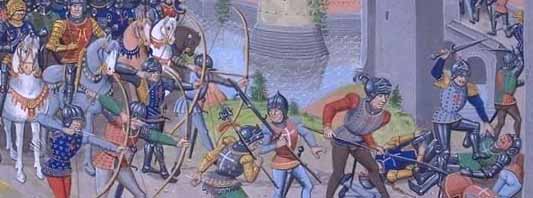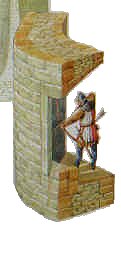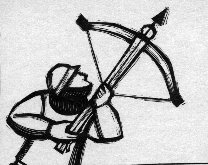
The garrison was the body of soldiers who lived in a castle and defended it. Castles usually had a small garrison during peacetime and more men were recruited in times of trouble. The garrison was a supply of knights, men-at-arms, and squires. When under attack or siege, the lord and his family took shelter in the keep, and the garrison fought night and day to defend their lord�s home. Attackers would often surround the castle, and take it by force if the lord did not surrender immediately.
 |
The gatehouse, where people entered and exited the castle, was an obvious weak spot, so a whole team of men from the garrison usually defended it. Many castles were built with a drawbridge and porticullis for extra protection. The porticullis was an iron-covered wooden grille that moved up and down in slots on either side of the entrance passage. This could be dropped quickly if a soldier sensed danger. The drawbridge was a bridge crossing a moat or ditch, which could be crossed by the castle�s occupants, or raised in the event of danger to hinder the enemy�s attack. There were many kinds of drawbridges, ranging from simple wooden platforms to complicated chain and pulley systems or pivoting bridges. |
|
| Attackers often broke down the front gate with a battering ram. A wooden sheltered structure supported the ram, or wooden beam, with chains. One end of it was sharp and pointed, and capped with iron. This end was aimed at the wall and rocked back and forth until the gate crumbled. The offensive team of soldiers was somewhat protected by the wooden shelter overhead. The roof of the shelter was covered with raw, damp animal hide to protect the attacking soldiers from missiles thrown over the walls of the castle |
The attackers attempted to go over and under the castle's walls to assault the enemy. Some offenders dug tunnels beneath the castle to weaken the foundation and cause walls to crumble down, which was called undermining. Defenders might place bowls of water on the ground so that any tunneling activity made the water ripple. Sometimes they were able to dig countermines to break into the tunnels, which led to a brutal underground battle. A direct assault over the walls meant using scaling ladders to hook onto the castle�s walls. Attackers even brought boats with platforms to cross the river or moat and climb over the walls. Defenders often pushed these men away from the walls with forked poles, which could be very painful.
|
|
Castles were built with special features to protect the defenders while allowing them to fight back. Loopholes and murder holes were advantageous to defenders. Loopholes, like the one to the left, were usually splayed on the inside to form an open chamber within the wall. The archer probably stood just to one side, looking through the hole until an enemy came into range. Then he would move to the center of the chamber to shoot. Enemy marksmen may have go ten some arrows through loopholes, especially if they were at close shooting range. Murder holes existed in the roof of castle structures so that boiling water or oil, hot sand, or other offensive substances could be dropped on enemies who managed to get in. Severed heads, dung, or dead animals were sometimes thrown over the castle walls to scare the opposition. These not only intimidated the enemy, but also spread disease.
Many sophisticated weapons were developed over the Medieval Period. Battles could be extremely gruesome and bloody. Crossbows, longbows, swords, axes, spears, bows and arrows, and catapults were used on part of both the defenders and the attackers.
|
|
|
Crossbows shot short arrows called bolts. Their four-sided arrows made it especially difficult and painful to remove the bolt from the victim�s body. Every medieval soldier carried a dagger in his belt. He was always prepared in case he had to take part in hand-to-hand combat. A crossbow (top left) was powerful, but slow to reload. For this reason, they were commonly used within the safety of the castle. In some cases, an assistant might load a second crossbow while the crossbowman was aiming the first one. This speeded up the process. The longbow (bottom middle) could propel its arrows at least 1,000 feet. A longbowman could shoot twelve arrows in the same amount of time it took to load a crossbow, but he needed great strength to pull the bow with enough force. Robin Hood was famous for his mastery of the longbow. A catapult (bottom left) with springy arms threw missiles. These could be stationary or rolls on wheels. Attackers could shot arrows or hurl heavy rocks up to 1,475 feet away. They often lit arrows on fire to cause more destruction. To prevent fires in wooden towers people poured water over walls & draped over wet animal hides. |
Often times, armies of men fought without the defense of the castle. Only one of the sites of Arthur�s battles is clearly identified today: Celidon Wood in Scotland. A large forest once covered this area. Researchers believe that this was the same forest where Merlin may have lived as a hermit, or all alone in isolation. The location of Arthur�s death, also separate from the castle' is one of the few definite, historical facts in the legend. Both Arthur and Mordred were killed in a battle at a place called Camlann. Camlann may have actually been Camelot, since the names sound so similar.
<





